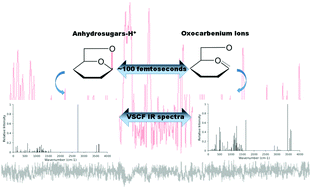Accueil du site > Production scientifique > Gas phase dynamics, conformational transitions and spectroscopy of charged saccharides : the oxocarbenium ion, protonated anhydrogalactose and protonated methyl galactopyranoside
Gas phase dynamics, conformational transitions and spectroscopy of charged saccharides : the oxocarbenium ion, protonated anhydrogalactose and protonated methyl galactopyranoside
Date de publication: 3 février 2020
M. P. Dvores ; P. Carcabal ; P. Maitre ; J. P. Simons ; R. B. Gerber
Phys. Chem. Chem. Phys. 22 4144-4157 (2020). DOI
Travail réalisé sur le site de l’Université Paris-Saclay.
Abstract

Protonated intermediates are postulated to be involved in the rate determining step of many sugar reactions. This paper presents a study of protonated sugar species, isolated in the gas phase, using a combination of infrared multiple photon dissociation (IRMPD) spectroscopy, classical ab initio molecular dynamics (AIMD) and quantum mechanical vibrational self-consistent field (VSCF) calculations. It provides a likely identification of the reactive intermediate oxocarbenium ion structure in a d-galactosyl system as well as the saccharide pyrolysis product anhydrogalactose (that suggests oxocarbenium ion stabilization), along with the spectrum of the protonated parent species : methyl d-galactopyranoside-H+. Its vibrational fingerprint indicates intramolecular proton sharing. Classical AIMD simulations for galactosyl oxocarbenium ions, conducted in the temperature range 300-350 K (using B3LYP potentials on-the-fly) reveal efficient transitions on the picosecond timescale. Multiple conformers are likely to exist under the experimental conditions and along with static VSCF calculations, they have facilitated the identification of the individual structural motifs of the galactosyl oxocarbenium ion and protonated anhydrogalactose ion conformers that contribute to the observed experimental spectra. These results demonstrate the power of experimental IRMPD spectroscopy combined with dynamics simulations and with computational spectroscopy at the anharmonic level to unravel conformer structures of protonated saccharides, and to provide information on their lifetimes.








